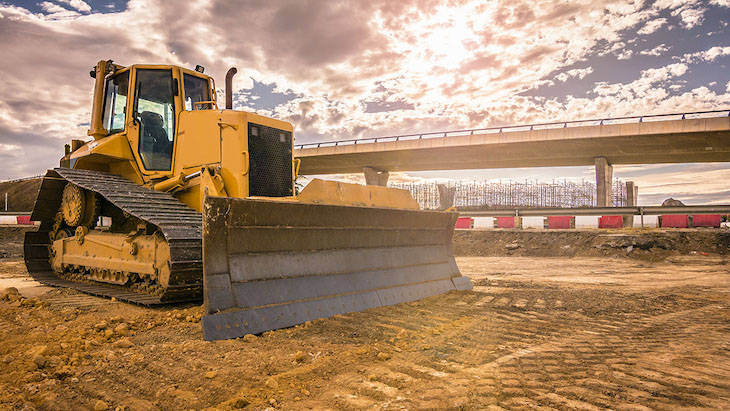
Bulldozers are high-powered, versatile machines used in construction, forestry operations, and mining. These machines are fashioned to move large amounts of earth and debris, making them perfect for various applications. The most common use of bulldozers is during road, residential or commercial construction, where a lot of digging into the earth is involved.
If you’re new to construction, it’s wise to understand bulldozer types, know when to use them, their benefits, and the factors to consider before doing so. Although the topic might sound complex, stick around for more insights.
Bulldozers Types
Bulldozers come in different types, sizes, features, and capabilities. More information about them will help you choose the suitable machine for any project and complete the job perfectly. Here are the different bulldozer types, uses, and detailed descriptions.
Crawler Bulldozers
Crawler bulldozers are the most common in construction and are mainly used in mining and construction sites. They’re designed differently with metallic tracks instead of wheels, allowing them to navigate rugged terrain easily. These bulldozers are perfect for heavy-duty projects like grading and excavation. Moreover, they’re also commonly used in forestry operations when clearing land for new vegetation.
Wheel Bulldozers
They are similar to crawler bulldozers, but wheel bulldozers are equipped with wheels instead of tracks. Wheel bulldozers are mainly used in agricultural and forestry applications and sometimes in construction projects where the terrain isn’t so rugged. These bulldozer types are also used to remove snow and road maintenance in municipal applications.
Mini Bulldozers
Mini bulldozers are smaller than standard bulldozers and are primarily used in landscaping and smaller construction projects. They are firm and easy to move, making them ideal to work in tight spaces. Mini bulldozers are also popularly used in residential constructions like driveway constructions and small retaining walls.
Swamp Bulldozers
Swamp bulldozers are fashioned for wetland environments and equipped with broad tracks. The tracks aid them in navigating through the soft and muddy terrain. They are mainly used in forestry projects to clear land for new vegetation and construct access roads in swampy areas.
Angle Dozers
Angle dozers have curved blades that push material to the side and straight ahead. Their design makes them ideal for projects where material needs to be moved to the side, like road construction projects. They’re also used in forestry operations like clearing land for new growth.
Hybrid Bulldozers
These are new bulldozer types that have a combination of a powerful diesel engine that is as efficient as an electric motor. They’re more fuel-efficient than the typical bulldozers and emit less carbon. Hybrid bulldozers are increasingly preferred for many construction projects and mining operations.
When Do You Need A Bulldozer?
Bulldozers are robust, flexible machines that can work in challenging areas. These are some of the everyday situations that might need a bulldozer:
- Land Clearing – You can use bulldozers to clear land before construction or for agricultural purposes. They remove obstacles like trees or stumps on land fast and efficiently, paving the way for new activity.
- Road Construction – During road construction, a lot of digging is necessary, making bulldozers the ideal machine. They level the ground and are commonly used in road construction projects to level the ground, build roadbeds, and create barriers.
- Mining – Bulldozers move large amounts of earth and debris in mining operations. They are also used to construct access roads and other infrastructure.
- Landscaping – Engineers use bulldozers to grade land for landscaping projects like installing a new lawn or garden.
How To Choose The Right Bulldozer For Your Project
The project you’re working on matters most when choosing a bulldozer. With so many options available, it may be an uphill task to get the suitable machine for the job. However, we have included some factors to consider when selecting a bulldozer.
- Size – The project you want to work on will determine the size of the bulldozer you need. Larger projects will require more extensive, powerful bulldozers.
- Power – The power of a bulldozer is crucial because more powerful machines are required for heavy-duty applications.
- Blade Type – The blade type on a bulldozer depends on the type of project. For instance, straight blades work well for general purposes, while angle blades are ideal for pushing material sideways.
- Track Type – Whether you choose to track or wheels mainly depends on the terrain of a project. Wide tracks are ideal for soft and muddy terrain, while narrow tracks work well on hard or rocky terrain.
Advantages Of Using A Bulldozer
Bulldozers are perfect for working on rugged grounds and large projects before construction and are beneficial in many ways. Here are the significant benefits:
- Efficiency – Bulldozers are efficient machines that move large amounts of material efficiently, making work more accessible.
- Versatility – Bulldozers are used differently, making them versatile machines for different jobs.
- Power – Bulldozers are potent machines that handle heavy-duty projects.
- Precision – Bulldozers are designed with blades for grading and levelling.
- Increased Productivity – Bulldozers work on extensive grounds. Hence, they get the job done quickly and efficiently. They can excavate significant ground and debris quickly, lowering labor costs.
The Downside Of Using Bulldozers
Bulldozers are heavy-duty machines used in constructing roads, forestry clearing, earthmoving, and demolishing unwanted buildings. While bulldozers are handy in heavy-duty projects, they also have some downsides, and they include:
- Limited Maneuverability – Bulldozers are big machines designed to push and pull heavy loads. However, they’re limited in maneuverability, making it difficult to operate them in tight or confined spaces.
- Environmental Impact – Bulldozers can negatively impact the environment through erosion, air pollution, and habitat destruction, mainly when used to clear land and construction.
- Noise Pollution – Bulldozers are noisy, making them a problem when working in a residential area. The loud noise can cause hearing impairment, disrupt sleep, and decrease productivity.
- Cost – Bulldozers are expensive to purchase, maintain, or hire. Repairing, replacement of parts, and maintenance can amount to significant expenses over time.
- Safety Risks – Bulldozers can be hazardous when poorly operated. Since they’re heavy machines, they can cause serious injuries or even fatalities if they tip over or collide with other equipment.
Conclusion
Generally, bulldozer types are variant, useful machines for large construction projects like roads and demolishing older or unwanted buildings. Bulldozers are powerful machines that can be used in individual or commercial projects due to their efficiency, flexibility, and high productivity. As powerful machines, they can work extensive grounds quickly, making them convenient and affordable for working on large projects.

